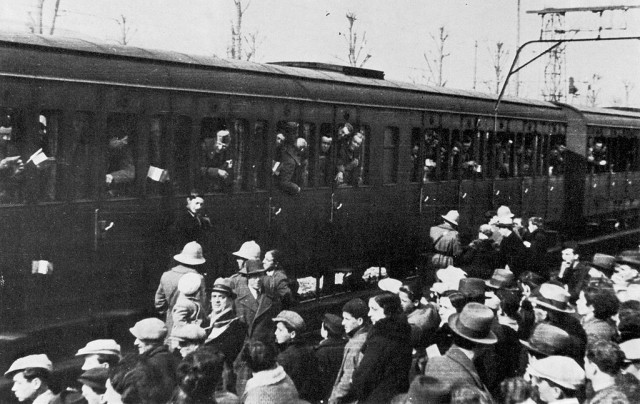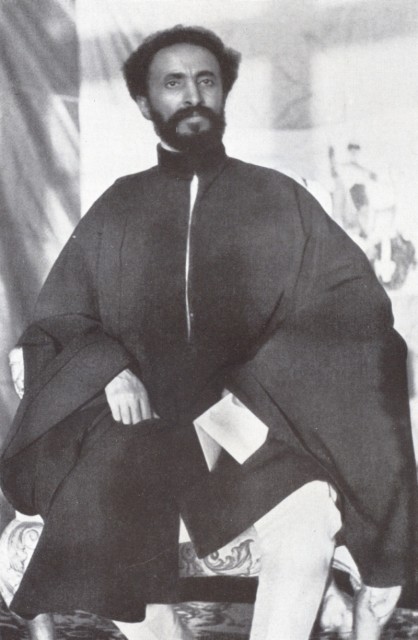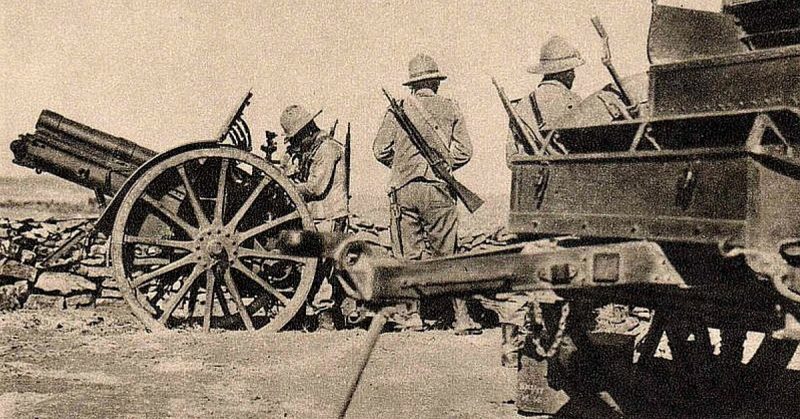Italy arrived a late in the colonial race but tried to catch up rapidly. In 1895, a full-scale war broke out between Italy and Ethiopia over a dispute concerning the latter becoming an Italian protectorate. Even though Italy was a technologically superior nation, Ethiopia mobilized a large number of troops and was aided by Russia with military experts and weapons.
The war also saw a united front of former opponents of the Ethiopian emperor – or Ras, as the title is domestically called – Menelik II, who overcame their petty differences and defeated the Italian invaders together. It was a triumph that went into the national myths of the Ethiopian people. The Italians had to retreat back to Somalia which was under their colonial control.
Exactly 40 years later, under the Fascist flag of Benito Mussolini, Italy wanted to revive its imperialist status.
The Walwal incident
Italy and Ethiopia (then known also as Abyssinia) didn’t normalize their diplomatic relations until 1928, when a treaty was signed, which was the final and official agreement on the borderline between the Italian Somaliland and Ethiopia. The Walwal oasis, in which the incident took place, was well within the Abyssinian territory. Nevertheless, the Italians broke the state’s sovereignty and built a fort in the oasis in 1934. The Ethiopians called on the treaty, but the invading force wouldn’t back down.
Between 5 and 7 December, for reasons which have never been clearly determined, there was a skirmish between the garrison of Somalis, who were in Italian service, and a force of armed Ethiopians. According to the Italians, the Ethiopians attacked the Somalis with rifles and machine-gun fire. According to the Ethiopians, the Italians attacked them, supported by two tanks and three aircraft. In the end, approximately 107 Ethiopians and 50 Italians and Somalis were killed. After this, the conflict heated up and attracted international attention.
The fragile relations between the two countries collapsed and war became imminent. Mussolini never hid his colonial ambitions, openly declaring the revival of the Roman Empire under his rule and adopting racist ideas about the “primitive peoples” of Africa. The war was, like the Mukden incident that caused the Japanese invasion of China, provided evidence that the League of Nations has no real power in world diplomacy.
The War

The opening phase of the war is considered to be the De Bono offensive in October 1935. Italian General, Emilio De Bono invaded Ethiopia from Eritrea (which was, like Somalia, also an Italian colony) establishing the Northern Front. The offensive started without a declaration of war, undermining the Ethiopian state and the international code of war. The attack force consisted of 125,000 Italian and Eritrean soldiers, while Emperor of Ethiopia, Haile Selassie I, could at that time muster only 15,000 trained soldiers.
At the same time, from the south, Italians together with their Somali counterparts started to push into Ethiopia. The League of Nations condemned the assault, calling Italy “an aggressor state”. Since the League of Nation had no military wing which could react and aid the endangered nation, it was a paper dragon and the Italians knew that and continued with their policy. The De Bono offensive ended in several skirmishes but without a decisive battle, as the Italians progressed slowly through the Ethiopian desert which had poorly paved roads.
The Ethiopians organized their own battle plan. What became known as the Ethiopian “Christmas Offensive” had as its objectives the splitting of the Italian forces in the north with the Ethiopian center, crushing the Italian left with the Ethiopian right, and invading Eritrea with the Ethiopian left.
Now the combined Ethiopian force had almost 200,000 fighters. The rough terrain and some old school tactics proved that the Ethiopians weren’t so incapable as the Italians saw them. They gained a major victory confronting an Italian division at the Dembeguina Pass in the northwest of the country.
The Italian commander, Major Criniti, commanded a force of 1,000 Eritrean Infantry supported by L3 tanks. When the Ethiopians attacked, Criniti’s force fell back to the pass, only to discover that 2,000 Ethiopian soldiers had occupied it. Criniti’s force was encircled and taking fire from all directions. In the first Ethiopian attack, two of Major Criniti’s officers were killed, and Criniti himself was wounded. Criniti’s force attempted to use their L3 tanks to break out, but the rough terrain immobilized the vehicles.
The Ethiopians slaughtered the infantry, then swarmed the tanks and killed their two-man crews. Italian forces organized a relief column made up of tanks and infantry to relieve Major Criniti, but it ran into an Ethiopian ambush on the way. The Ethiopians occupying the high ground rolled boulders in front of and behind several of the tanks, immobilizing them. The Ethiopians picked off the Eritrean infantry and swarmed the tanks. The other tanks were immobilized by the terrain and unable to advance further. The Ethiopians set two of these tanks on fire.
Meanwhile, Major Critini achieved a breakout, having ordered his men to fix bayonets and charge. Although half of the Major Critini’s force was killed in the fierce fighting, they managed to break out of the Ethiopian encirclement. The Ethiopians claimed to have killed 3,000 Eritrean troops during the Christmas offensive.

After this glorious moment in the Ethiopian defense effort, the Emperors power began to decline. The Italians realized that the occupation wasn’t going to be easy ― the Eritreans and other colonial troops weren’t so eager to fight the Ethiopians, at least not as eager as the later were to defend their country. Furthermore, the technology was unreliable on the robust terrains of East Africa. Instead, they decided to use mustard gas, bombers, and long-range artillery to force the Emperor Haile Selassie I to capitulate.
The League of Nations again condemned the use of chemical weapons, while Mussolini insisted that i was only a mixture of tear gas intended to incapacitate the opponents, rather than to murder them. This, of course, was a notorious lie, since more than 100,000 Ethiopians, both soldiers and civilians, died from mustard gas poisoning. In the end, the badly equipped Ethiopian Army, which still used swords and spears because of the lack of firearms, was subdued by the invader without significant resistance.
The Emperor fled to England, while the capital city, Addis Ababa, slipped into anarchy when an angry mob destroyed all shops owned by Europeans.
The Italians marched in on May 5, 1936, and on June 1, Ethiopia was officially annexed by Italy, which de facto was the end of the war, even though the Ethiopians never formally surrendered. On this occasion, Mussolini held a speech in Rome:
“During the thirty centuries of our history, Italy has known many solemn and memorable moments – this is unquestionably one of the most solemn, the most memorable. People of Italy, people of the world, peace has been restored. At last, Italy has her empire. The Italian people have created an empire with their blood. They will fertilize it with their work. They will defend it against anyone with their weapons. Will you be worthy of it?”
